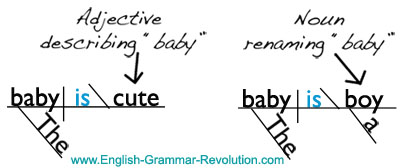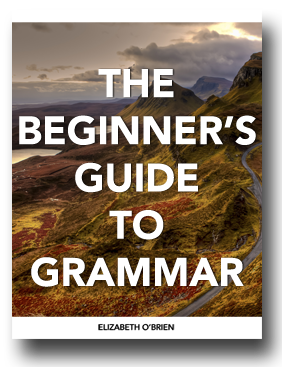Download your free grammar guide here.
Download your free grammar guide here.
Chapter 7: Diagramming Linking Verbs & Passive Verbs
Chapter 7: Diagramming
Linking Verbs & Passive Verbs
- Home
- How to Diagram
- Diagramming Linking & Passive Verbs
In the first five chapters, you diagrammed intransitive complete verbs, and in the last chapter, you diagrammed transitive active verbs. Here's a tiny review of how to diagram those types of verbs:

1. Intransitive Complete Verb

2. Transitive Active Verb
In this chapter, you'll learn how to diagram the last two types of verbs.

3. Transitive Passive Verb

4. Intransitive Linking Verb
7.0 Diagramming Passive Verbs
Your Mini Lesson on Passive Verbs
Transitive passive verbs are a type of action verb.
In all of the verb types that you have diagrammed so far, the subject has performed the action. In passive verbs, the subject receives the action!
The candle was lit.
Candle, the subject of the sentence, is receiving the action. It is being lit. Notice that we don't know who lit the candle. Many times, the doer of a passive sentence will be in a prepositional phrase.
The candle was lit by Joe.
Now we know who lit the candle. The doer of the action, Joe, is found in the prepositional phrase, by Joe.
Notice also that the verbs in passive sentences always have a helping verb was and the past participle form of the main verb (lit).
TRANSitive passive verbs TRANSfer their action to the subject of the sentence.

The ball was kicked by the baby.
Directions: Diagram the following sentences.
1. The book was written by Victor Hugo.
2. The victory was celebrated by the winners.
3. The plant in the corner was watered by the housekeeper.
4. My car was stolen yesterday!
5. Talkative children are scolded by the principal.
7.1 Diagramming Linking Verbs
Your Mini Lesson on Intransitive Linking Verbs
Linking verbs, the fourth and final verb type, link the subject to either a noun that renames it or an adjective that describes it.
INtransitive linking verbs do NOT transfer action! (In- is a Latin prefix that means not.)
The candle was bright.
Was is a linking verb connecting the subject, candle, with the adjective bright. Bright describes the candle.
Mrs. Johnson is my teacher.
Is is a linking verb connecting the subject, Mrs. Johnson, with the noun teacher. Teacher renames Mrs. Johnson.
There are only 13 linking verbs. See them here.

The baby is cute. The baby is a boy.
Directions: Diagram the following sentences.
1. I will be a great musician.
2. Mmm! The chili smells absolutely delicious!
3. My dad became very happy at Disneyland.
4. This bed feels soft.
5. After tomorrow, Grace will be a college graduate.
7.0 Diagramming Passive Verbs - Answers
Get these answers in the ebook!
Would you like to download these sentence diagramming exercises?
- 121 Pages
- Ebook, Instant Download
- Includes Instructions & Exercises For Diagramming Subjects, Verbs, Adjectives, Adverbs, Prepositional Phrases, Conjunctions, Interjections, Adverb Clauses, Adjective Clauses, Noun Clauses, Gerunds, Participles, & Infinitives
- Includes All Answers
- Printable
- 100% Money-Back Guarantee
- Only $19
7.1 Diagramming Linking Verbs

Would you like to download these sentence diagramming exercises?
- 121 Pages
- Ebook, Instant Download
- Includes Instructions & Exercises For Diagramming Subjects, Verbs, Adjectives, Adverbs, Prepositional Phrases, Conjunctions, Interjections, Adverb Clauses, Adjective Clauses, Noun Clauses, Gerunds, Participles, & Infinitives
- Includes All Answers
- Printable
- 100% Money-Back Guarantee
- Only $19
This is original content from https://www.english-grammar-revolution.com/verb-types.html
I love your enthusiasm for this subject!
- Laura, Homeschooler
Our Free Guide Gives You A Fun Way
To Teach And Learn The Basics v

Elizabeth O'Brien is the creator of Grammar Revolution.
Her lessons are guaranteed to give you more confidence in your communication skills and make you smile. :)



